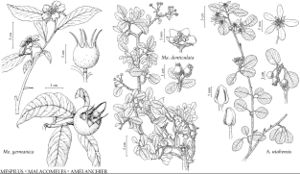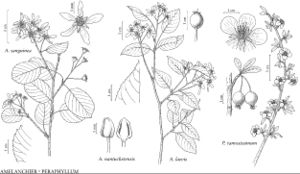Amelanchier
Philos. Bot. 1: 135, 155. 1789.
Shrubs or trees, sometimes fastigiate, 2–250 dm; suckering and/or rhizomatous, sometimes forming colonies. Stems 1–150, erect to ascending; bark usually gray, sometimes brown or salmon colored, smooth or fissuring in older trees; short-shoots present or absent; unarmed; young stems glabrous or hairy. Leaves deciduous, cauline, simple; stipules caducous, free, linear, margins entire; petiole present; blade elliptic, elliptic-oblong, elliptic-oval, ovate, oval, oblanceolate, oblong, oblong-ovate, obovate, quadrangular, suborbiculate, or orbiculate, 0.2–10 × 0.2–6 cm, membranous to coriaceous, base tapering or truncate to rounded or cordate, margins flat, entire or serrate, sometimes doubly serrate, or dentate distally or throughout, venation pinnate, apex acuminate to truncate or retuse, or mucronate to apiculate, abaxial surface glabrous or sparsely to densely hairy by flowering, glabrous or ± hairy at maturity, usually paler than adaxial surface. Inflorescences terminal, arching, ascending, erect, or drooping, sometimes spreading or nodding, 1–4-flowered clusters or 4–17-flowered racemes (panicles); bracts absent; bracteoles sometimes present. Pedicels present, proximal 1–3 subtended by leaves. Flowers opening during leaf expansion, perianth and androecium epigynous, 10–55 mm diam.; hypanthium campanulate or funnelform to saucer-shaped, 3–9 mm diam., hairy or glabrous; sepals 5, erect to reflexed, triangular to lanceolate; petals 5, usually white, sometimes ivory, rarely ± pink, linear to orbiculate; stamens 7–28, shorter than or equal to petals; carpels 2–5, connate, adnate to hypanthium, ovary 6–10-loculed by false partitions, apex densely hairy or glabrous, styles 2–6, terminal, distinct or ± connate; ovules 2. Fruits pomes, bluish or purplish to nearly black, pinkish or maroon-purple, dark purple-blue, or brownish, globose (pear-shaped in A. bartramiana), 6–15 mm diam.; taste insipid to sweet; hypanthium persistent; sepals persistent, erect to strongly reflexed; carpels cartilaginous; styles sometimes persistent. Seeds absent or few. x = 17.
Distribution
North America, nw Mexico, Europe, e, w Asia, n Africa
Discussion
Species ca. 20 (18 in the flora).
Amelanchier plants grow well in full sun and tend to form larger populations in more or less disturbed habitats and woodland margins.
Identification from herbarium specimens is often inconclusive. Identification is best undertaken in the field, with visits during flowering and fruiting seasons, and observations of habitat, habit, presence of congeners, and flowering time relative to sympatric congeners.
No consensus exists regarding the enumeration of North American Amelanchier taxa. J. B. Phipps et al. (1990) listed about 33 species in the North Temperate Zone and about six in the Old World. In eastern North America, most floras and regional treatments have roughly the corresponding number (although sometimes not the same species) as G. N. Jones (1946); often substantial differences of opinion exist regarding circumscriptions of individual taxa. Disagreement is deeper for western North America, for which Jones had seven species and P. Landry (1975) had but one. W. H. Blanchard (1907) observed that diverging and intergrading forms are abundant in the genus, and M. L. Fernald (1946e) remarked that no genus in North America, except Rubus and Crataegus, has offered so much perplexity and such contradictory treatment as Amelanchier.
Identification of Amelanchier taxa is difficult because the genus has relatively few taxonomically informative morphologic characters, and some of these are variable. Leaves vary in shape between and within individuals, depending on whether they are on reproductive or sterile branches, on rapidly or slowly growing shoots, or at the tip or near the base of a branch. Habit also varies within species. Amelanchier arborea can develop into a single-stemmed tree and can flower when stems are less than one meter. Adverse conditions can constrain arboreal species to less than a meter in height for many years. Amelanchier is taxonomically complex also because some species have not diverged much from one another genetically. C. S. Campbell et al. (1997) reported low levels of divergence among North American species in sequences from the internal transcribed spacer (ITS) of nuclear ribosomal DNA, and R. D. Overath and J. L. Hamrick (1998) found little divergence in allozymes between A. arborea and A. laevis.
Interspecific hybridization is frequent among eastern North American Amelanchier taxa (K. M. Wiegand 1912; E. L. Nielsen 1939; M. L. Fernald 1950; J. E. Cruise 1964; L. Cinq-Mars 1971; S. M. McKay 1973; P. Landry 1975; W. A. Robinson 1982; E. G. Voss 1972–1996, vol. 2; C. S. Campbell and W. A. Wright 1996; A. C. Dibble et al. 1998; A. Haines and T. F. Vining 1998; H. R. Hinds 2000). Amelanchier bartramiana, for example, has been reported to hybridize with all 11 other species with which it is sympatric. G. N. Jones (1946) considered hybridization to be insignificant.
Hybridization is important and has varying consequences in Amelanchier, one of which is illustrated by A. bartramiana and A. laevis. These two species usually hybridize when they grow together, but at one well-sampled site, the F1, A. bartramiana × A. laevis (often referred to by the invalid name A. ×neglecta Eggleston), apparently does not reproduce (J. E. Weber and C. S. Campbell 1989). Hybrids of other taxa have reproduced and spawned hybrid swarms (J. E. Cruise 1964; Campbell and W. A. Wright 1996). Wide dispersal of hybrids can be inferred from the distributions of A. arborea and A. laevis, both of which include allopolyploid plants (R. D. Overath and J. L. Hamrick 1998) found over much of eastern North America. These two species, like many others in Amelanchier, consist of both diploids and tetraploids (Cruise; W. A. Robinson and C. R. Partanen 1980; Campbell et al. 1985; A. C. Dibble et al. 1998; M. B. Burgess et al., unpubl.).
Ploidy levels noted for each taxon in the treatment below (2n = 2x indicates diploidy, 3n = 3x triploidy, and 2n = 4x tetraploidy) were determined by flow cytometry by M. B. Burgess et al. (unpubl.) or are from publications to be cited by Burgess et al.
The interplay of hybridization and agamospermy has the potential for generating considerable taxonomic complexity in Amelanchier. Agamospermy has been documented in five species, one informally named taxon (“A. erecta” [not A. erecta Blanchard]), and two putative hybrids (C. S. Campbell et al. 1985, 1987; Campbell and W. A. Wright 1996; J. E. Weber and Campbell 1989; A. C. Dibble et al. 1998; M. B. Burgess et al., unpubl.). Given that agamospermy is strongly associated with polyploidy in Amelanchier and close relatives (Campbell et al. 1991) and that polyploidy predominates in North American Amelanchier, agamospermy is assumed to be widespread in North American amelanchiers. Amelanchier agamosperms that have been studied are facultative; they can produce seed both sexually and asexually. What is most pertinent to the taxonomy of the group is that the phenotypes of agamosperms can be perpetuated and, if a particular phenotype disperses over some appreciable geographic range, could be recognized taxonomically. Phenotypes that are more or less distinct and have a limited geographic range can be called microspecies (Campbell and Wright). Examples of well-characterized microspecies are presented in the treatments of A. laevis and A. spicata.
Species of Amelanchier are used in horticulture, and cultivars of A. alnifolia, A. canadensis, A. laevis, and A. lamarckii Schroeder are especially popular. Amelanchier lamarckii was named from plants grown in European gardens from plants originally from eastern North America (F.-G. Schroeder 1968). It appears that plants resembling A. lamarckii have escaped from cultivation in North America. Cultivars of A. alnifolia are grown as fruit crops. Amelanchier fruits are important to birds and other wildlife because of their size, availability, sweetness, and early ripening.
For additional information about this genus, see http://biology.umaine.edu/Amelanchier/.
Selected References
None.
Lower Taxa
Key
| 1 | Inflorescences (1 or)2 or 3(or 4)-flowered; pomes pear-shaped. | Amelanchier bartramiana |
| 1 | Inflorescences (3–)5–12(–17)-flowered; pomes globose | > 2 |
| 2 | Petals (2.2–)3–4.5(–6.8) mm (sometimes bearing 1 or 2 tiny pollen sacs near margins on adaxial surfaces). | Amelanchier nantucketensis |
| 2 | Petals (4–)5–20(–23.2) mm (not bearing pollen sacs) | > 3 |
| 3 | Leaves: each margin with (0–)4–9(–20) teeth in distalmost cm | > 4 |
| 3 | Leaves: each margin with (0–)2–6(–11) teeth in distalmost cm | > 10 |
| 4 | Leaves: abaxial surfaces densely (moderately) hairy by flowering | > 5 |
| 4 | Leaves: abaxial surfaces glabrous or sparsely hairy by flowering | > 7 |
| 5 | Petals (8–)10–15(–19) mm; leaf apices acute to acuminate; sepals soon reflexed after flowering; shrubs or trees. | Amelanchier arborea |
| 5 | Petals (4–)6–10.2(–15) mm; leaf apices rounded or acute to obtuse and mucronate; sepals erect, spreading, or recurved after flowering; shrubs | > 6 |
| 6 | Leaf blades oval to orbiculate; sepals recurved after flowering; ovary apices densely hairy (or glabrous). | Amelanchier spicata |
| 6 | Leaf blades elliptic or oval to oblong or obovate; sepals erect, ascending, or spreading after flowering; ovary apices glabrous (or moderately hairy). | Amelanchier canadensis |
| 7 | Ovary apices usually densely (moderately) hairy | > 8 |
| 7 | Ovary apices glabrous (or sparsely hairy) | > 9 |
| 8 | Shrubs, 0.5–1 m (rhizomatous); stems 1–50, usually forming colonies. | Amelanchier fernaldii |
| 8 | Shrubs or trees, 1–10 m; stems 1–10, forming colonies or solitary. | Amelanchier interior |
| 9 | Leaves: abaxial surfaces sparsely hairy by flowering. | Amelanchier intermedia |
| 9 | Leaves: abaxial surfaces glabrous (or sparsely hairy) by flowering. | Amelanchier laevis |
| 10 | Styles (2 or)3 or 4 | > 11 |
| 10 | Styles (2–)4 or 5(or 6) | > 13 |
| 11 | Proximalmost pedicels (8–)12–18(–25) mm. | Amelanchier pallida |
| 11 | Proximalmost pedicels (2–)6–16(–25) mm | > 12 |
| 12 | Leaf blades (6–)16–24(–31) mm; petioles (2.5–)3.4–6(–8) mm. | Amelanchier nitens |
| 12 | Leaf blades (14–)21–36(–63) mm; petioles (3–)6–13(–22) mm. | Amelanchier utahensis |
| 13 | Petals 4.3–14 mm, usually less than 9 mm | > 14 |
| 13 | Petals 4.9–23.2 mm, usually more than 9 mm | > 16 |
| 14 | Styles (2.2–)3–3.8(–4.6) mm. | Amelanchier spicata |
| 14 | Styles (1.7–)2.3–3(–3.9) mm | > 15 |
| 15 | Sepals (1.6–)2.6–4.2(–6.5) mm. | Amelanchier utahensis |
| 15 | Sepals (1–)1.6–2.7(–3.6) mm. | Amelanchier humilis |
| 16 | Leaves: each margin with 0–3(–11) teeth on proximal 1/2 | > 17 |
| 16 | Leaves: each margin with (0–)4–10(–16) teeth on proximal 1/2 | > 19 |
| 17 | Petals usually less than 9.8 × 3.1 mm. | Amelanchier utahensis |
| 17 | Petals usually more than 9.5 × 3.3 mm | > 18 |
| 18 | Petals (5.7–)9–14(–18.8) mm. | Amelanchier alnifolia |
| 18 | Petals (10.8–)13.3–20.1(–23.2) mm. | Amelanchier cusickii |
| 19 | Ovary apices glabrous or sparsely hairy. | Amelanchier cusickii |
| 19 | Ovary apices densely (moderately) hairy | > 20 |
| 20 | Petals (15–)16.6–19.7(–22) mm. | Amelanchier amabilis |
| 20 | Petals (8–)9.7–16.1(–20) mm | > 21 |
| 21 | Petals (8–)10.7–16.1(–20) mm. | Amelanchier sanguinea |
| 21 | Petals (8–)9.7–13.5(–15) mm. | Amelanchier gaspensis |

